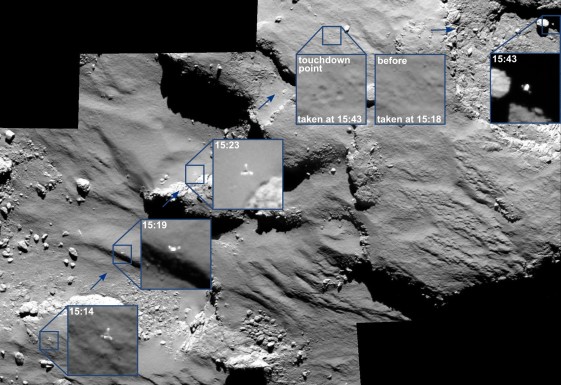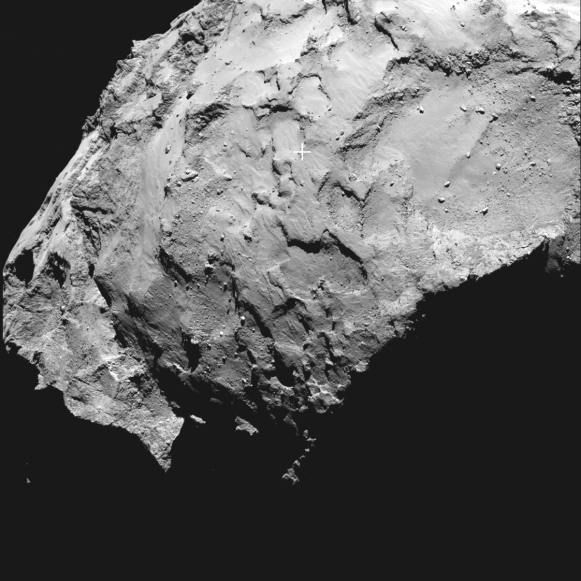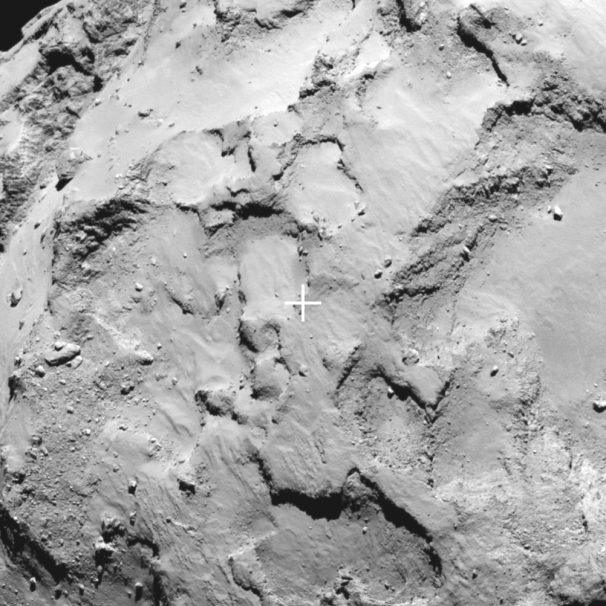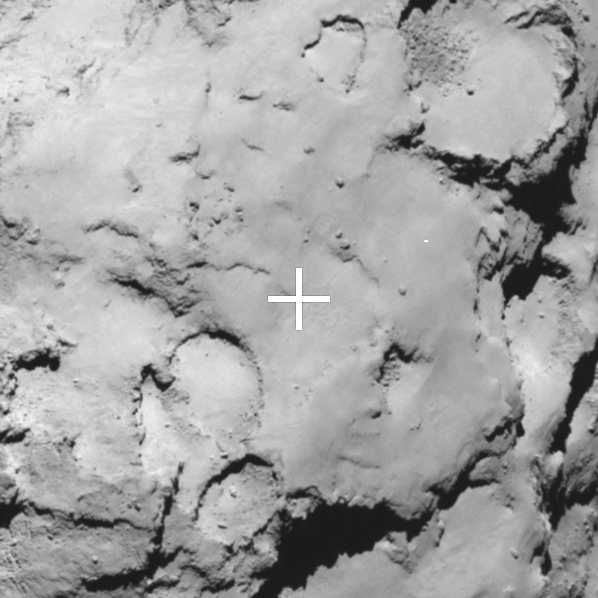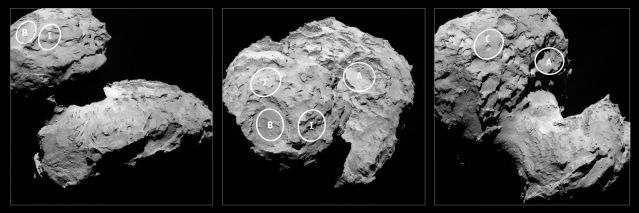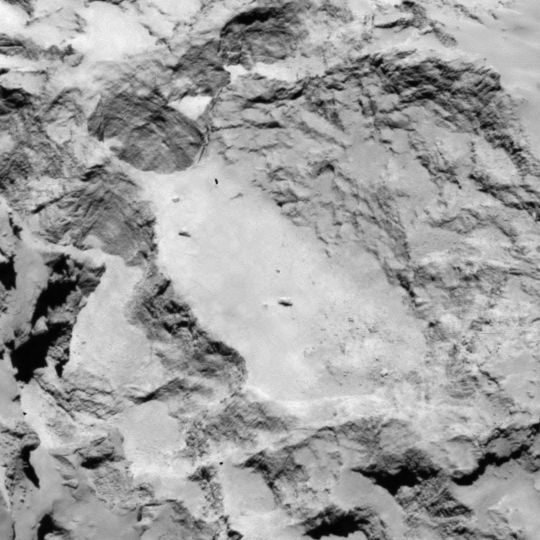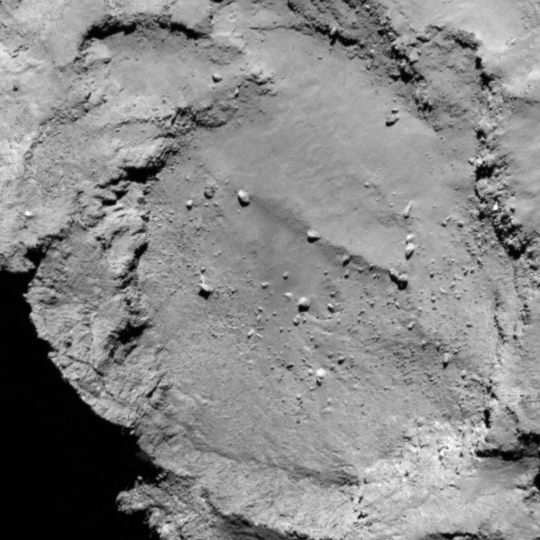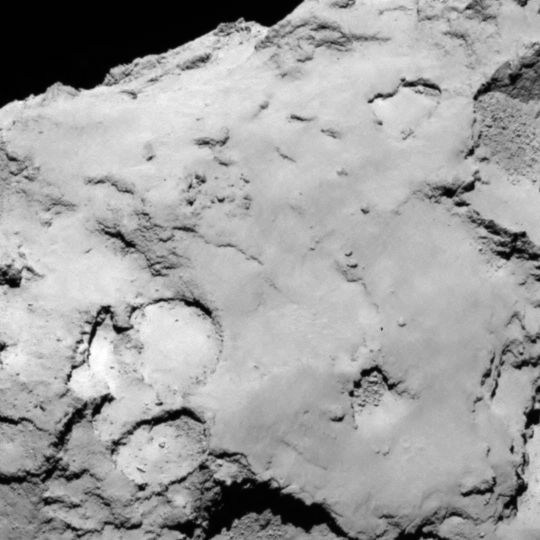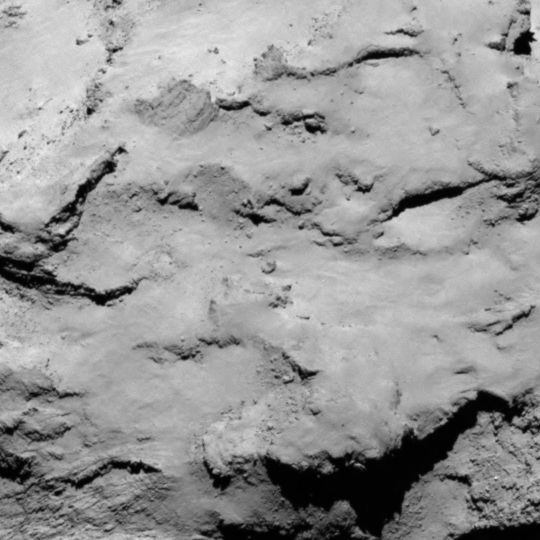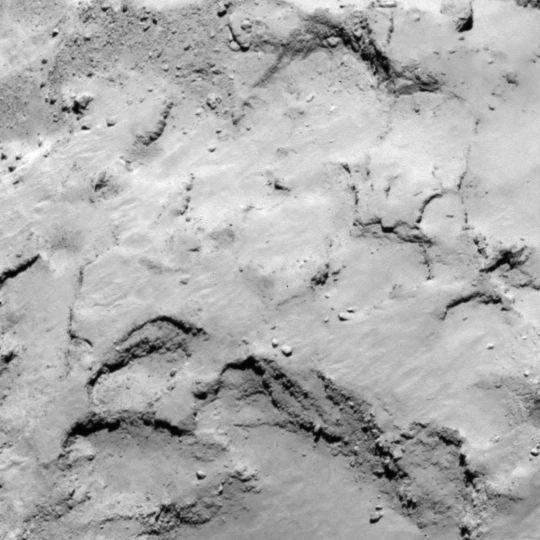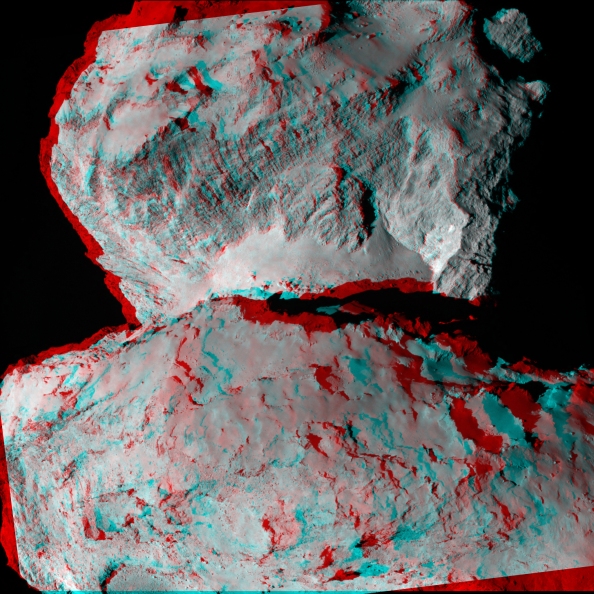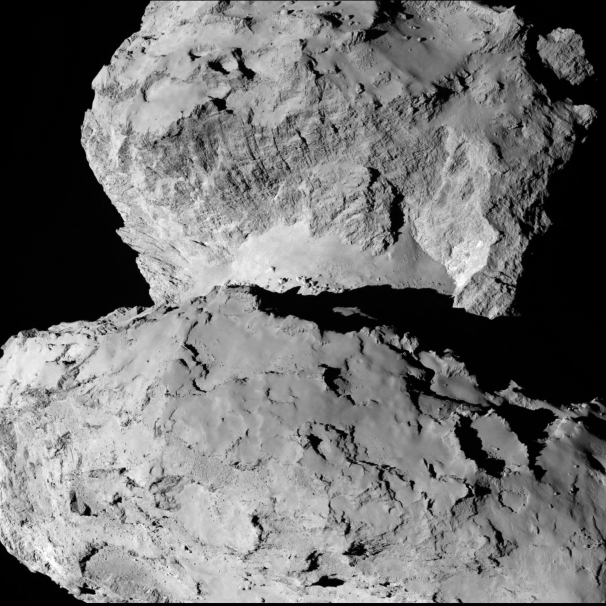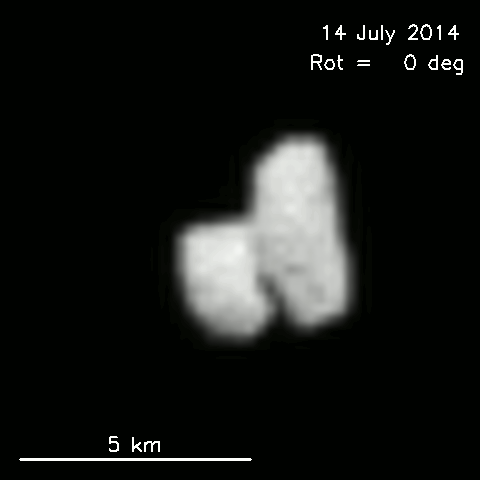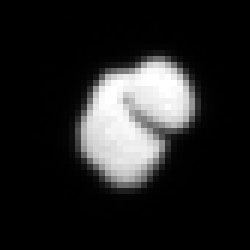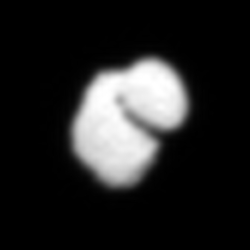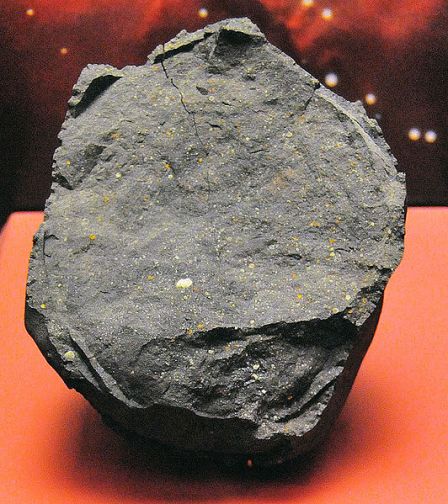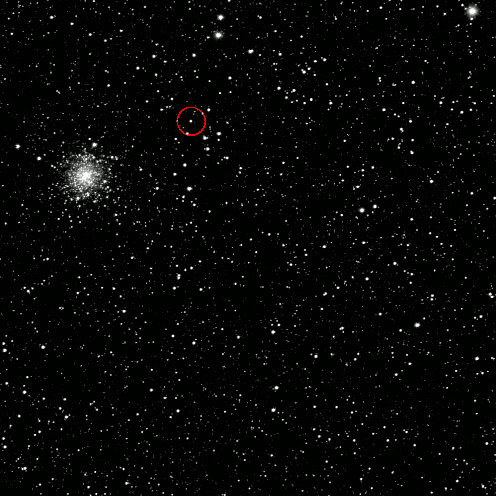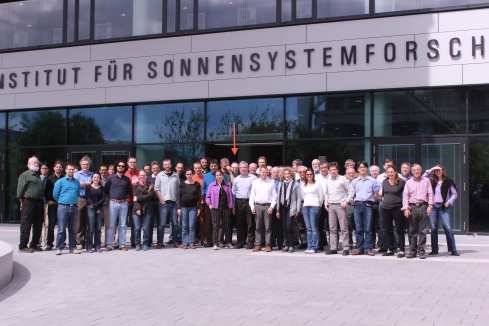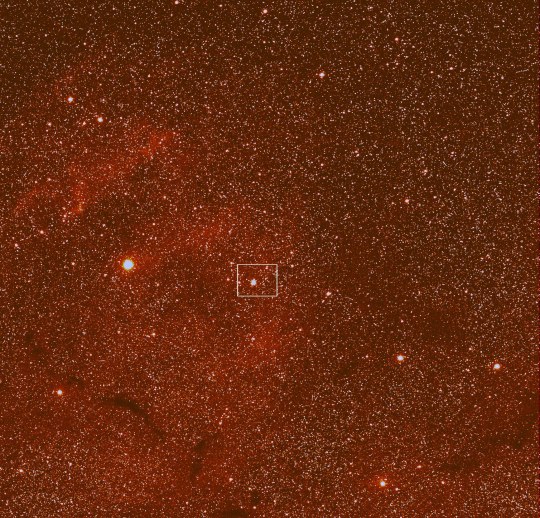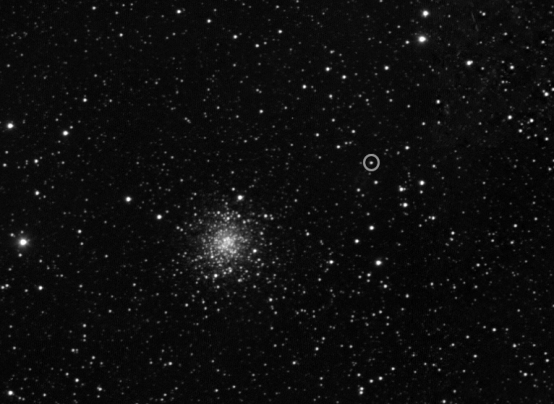Our large article about the origin of comets has finally been published! I and my 47 co-authors from Rosetta’s OSIRIS team have made a thorough summary of what we have learned from the spacecraft’s exploration of comet 67P/Churyumov-Gerasimenko, combined with information from other spacecraft and observations of the outer solar system from ground, with the purpose of clarifying which of the previously proposed theories of comet formation that is closest to the truth, and what relation comets have to other types of bodies in the outer solar system. During that process we have realized that none of the earlier theories are fully satisfactory and we propose a new hybrid model that combines elements from earlier hypotheses in a unique manner.
The article has been published in the international scientific journal Astronomy & Astrophysics and can be downloaded here. The European Space Agency ESA, which led the construction of Rosetta and is responsible for the daily operations of the spacecraft and its orbital maneuvers, have also made a short popular summary of the article in their blog, where text and graphics have been produced in collaboration with me.
I will write several blog posts that describes various aspects of this paper. This is the first one which briefly describes earlier theories and our new scenario, step by step. Later posts will focus on different topics: what observations we used; why we consider certain theories inconsistent with those observations; why we were forced to introduce new concepts – and perhaps most important of all – what are the consequences of this new work regarding our understanding of early solar system history?
It has long been known that the interstellar medium, from which new stars and planetary system are made, contains a very large number of dust grains consisting of silicates, sulfides, metals, organic substances, and ice, whose diameters are less than a micrometer (i.e., one part in one thousand of a millimeter). It was also known that the newly formed protosun surrounded itself by a flattened and extensive disk of gas and dust known as the solar nebula, however, the processes that were responsible for transforming this smoke to a planetary system have been less understood. What is really going on when myriads of little grains merge to form large planets like Earth, or beasts like Jupiter? Over the years a number of theories have been proposed, where gravitational instabilities, hierarchical agglomeration (also known as hierarchical coagulation), and streaming instabilities played particularly important roles. They all aim at explaining how planetesimals are formed – small bodies with diameters ranging from a few hundred meters to a thousand kilometers that gradually merge into large planets.
Gravitational instability
This is the oldest model in modern times, that dominated our thinking in the 1960’s. According to this model a sedimentation process occurred in the solar nebula – the small dust grains gradually sunk towards the midplane. The gas disk was rather thick while the dust formed a thinner slab with an ever decreasing thickness. Because of this the density of the dust disk grew large over time, when all grains tried to fit within a comparably small volume. The reason why individual grains moved toward the midplane is the force of gravity emanating from all other grains. However, the dust disk cannot become arbitrarily thin and dense. Calculations of the strength and direction of the gravity field within the dust disk showed that it would break up into a large number of smaller isolated plates once a certain critical density was reached. It was this sudden breakup of the disk into smaller plates that constituted the instability. Under the influence of gravity the plates then collapsed to form spherical planetesimals with sizes of hundreds of kilometers. In this model gravity was therefore solely responsible for transforming the rocky smoke to a planetary system.
Hierarchical agglomeration
Toward the end of the 1970’s people started to question this type of gravitational instability. The solar nebula gas is denser and warmer close to the protosun, but thins out and gets colder at larger distances from it. For this reason a pressure forms in the gas that slightly counters the force of gravity. The result is that the gas disk orbits the protosun at somewhat lower velocity than what a planet at a corresponding distance would have done. We say that the gas has a sub-keplerian motion, while a planet has keplerian motion. However, the dust grains that accumulate in a thinner disk near the midplane does not feel this pressure, which is why the dust moves in a keplerian manner and also forces the gas in its immediate vicinity to do the same. For this reason a layer of dust and gas emerges near the midplane that moves around the protosun with a higher velocity than the gas under and above the midplane. The consequence is well known for those who have seen a wind blow over a calm lake – if the wind is weak nothing happens but if the wind velocity exceeds a critical value ripples form on the surface of the water. The ripples are examples of the Kelvin-Helmholtz instability that arises when two media with different density has sufficiently fast relative shearing velocity. People realized that the Kelvin-Helmholtz instability near the midplane would make the gas there turbulent and that this turbulence prevented the dust disk from becoming sufficiently thin and dense for the gravitational instability to occur. Gravity was simply incapable of forming planetesimals because the turbulence was too strong. It was necessary to search for other mechanisms that did not rely on gravity.
It was realized that the so called van der Waals force could be the solution to the problem. Small dust grains that collide tend to stick together, due to a weak attractive force that arises between molecules in the grain surface layers when in physical contact. If grains merged to ever larger units then planetesimals would grow gradually without the assistance of gravity, at least initially. The process of grain sticking in collisions is called agglomeration and since large planetesimals are formed by mergers between smaller ones their structure forms a hierarchy – the model is therefore often referred to as hierarchical agglomeration.
This model dominated the thinking about planetesimal formation during the 1980’s and 1990’s. Very advanced computer codes were designed to figure out exactly how the hierarchical agglomeration behaved in the complex environment of the solar nebula, where turbulence, gas drag forces (similar to air resistance), material forces and gravity caused the piles of grains to collide, fragment, bounce, and merge on their winding road leading from the solar nebula to a planetary system. On ground, in space shuttles, and in space stations a large number of laboratory experiments were performed aimed at measuring the outcome of collisions between different types of grain clusters at different speeds, so that the computer codes could be fed with data with increasing quality and realism.
The theoretical studies of hierarchical agglomeration showed that the process was very promising – many computer simulations showed that it was possible to form planetesimals in this manner, and that they would have properties that resembled those observed for the asteroids in the belt between Mars and Jupiter, and seen among the large transneptunians in the Edgeworth-Kuiper belt beyond Neptune. However, the experiences were not exclusively positive. One problem was that the process was very slow: the cores of Jupiter, Saturn, Uranus, and Neptune need to reach a certain size before the gas dissipates in the solar nebula when it reaches an age of about 3 million years – otherwise they do not have time to accrete the gas from the solar nebula that they largely consist of. Hierarchical agglomeration did not seem to manage, except during certain conditions. Some imagined that the solar nebula may have contained very large amounts of dust, so that the hierarchical agglomeration proceeded sufficiently fast. That means that a large number of planetesimals remain once the planets have formed – far too many compared to the observed number of asteroids and transneptunians. Possibly this problem could be solved if the planetesimals collided violently with each other at a later stage so that the excess was ground down to sand. This idea was reasonable since the planets gradually changes the orbits of the planetesimals in such a manner that their collisions become increasingly violent. Therefore, it was generally assumed that only the largest bodies in the asteroid belt and the Edgeworth-Kuiper belt had survived more or less intact since the early solar system, while most smaller bodies had formed gradually by the grinding process. Such collision cascades have been studied thoroughly to understand how they function.
Other problems are known as the drift barrier and the bouncing barrier. The drift barrier is a result of the drag forces that act when a small planetesimal try to move at keplerian velocity through the slower sub-keplerian gas and therefore feels a constant air resistance. These drag forces makes the planetesimal spiral toward the protosun. The speed during this sunward drift can reach very high values for bodies with sizes around a meter, while bodies that are either much smaller or substantially larger than this have a significantly slower drift speed. Under certain conditions the meter-sized bodies can drift so fast that the solar nebula quickly looses all its rock, that is completely engulfed by the protosun. The drift barrier means that planets cannot form at all since the construction material disappear completely from the solar nebula early on. Subsequent research has shown that the drift barrier may be breached if the small planetesimals are very porous. Early work on hierarchical agglomeration did not take porosity into account, which is why the drift barrier problem may have been exaggerated. Later laboratory experiment have shown that the mergers of grains at low velocity creates extremely porous bodies. If this is accounted for the drift barrier seems less problematic – there are paths to gradual growth that Nature may have treaded 4.6 billion years ago.
The bouncing barrier is a problem that was discovered during laboratory experiments with dust balls consisting of small silica grains. Those are sufficiently sticky (due to the van der Waals force) that micrometer-sized grains can merge to extremely porous pebbles with diameters ranging millimeters to centimeters. However, at that point the growth grinds to a halt. When the porous pebbles collide with each other they do not merge into larger bodies but just bounce. The planet formation stops at a very early stage if the bouncing barrier is a reality. However, also in this case there seems to be ways around the problem.
Computer simulations are often so extremely complex and time consuming that it is practically necessary to make simplifications to make any kind of progress. However, some of these simplifications may turn out to be fatal. For example, it has often been assumed that the collision between two pebbles (say one with 1 millimeter diameter and another with 2 millimeter diameter) always occur at a certain velocity that is regulated by the dynamics of the two pebbles as determined by the local gravity field and drag forces according to local turbulent conditions. But Nature is never that simple, and it is more likely that such collisions take place with different velocities according to some statistical probability – perhaps 60% of the collisions take place at 1 meter per second, but in 2% of the cases the speed is perhaps just 0.1 meter per second by chance. If one erroneously assume that all collisions are exactly at 1 meter per second – motivated by the majority of cases – this may lead to a bottleneck, or in the worst case, a dead end. But if one allows for a natural spread in collision velocities, it is possible that the unusually low velocities actually allows for a limited growth, that later leads to dramatic consequences for how the entire collective of grains, pebbles, and boulders behave – there is a way around the bottleneck and the planet formation process continues.
Another aspect is that laboratory experiments based on silica grains may be a very realistic analogue for material in the warm inner solar system, but not necessarily for the cold outer solar system. Beyond Jupiter’s orbit it is so cold that the rocky grains are covered by organic substances, ordinary crystalline water ice, and a type of structure in frozen water that only arise when it is formed at extremely low temperature – amorphous water ice. Organic substances and crystalline ice is much stickier than silica grains, and amorphous ice is stickier still. It is extremely difficult to make realistic laboratory experiments with such material. Only in recent years there have been published results from laboratory experiment were icy grains with the right dimensions where produced in a controlled way, and investigations of how their hierarchical growth differs from that of silica has begun. Experiments with organic species are also very few and as far as I know agglomeration experiments with amorphous ice have never been done. Preliminary results indicates that the bouncing barrier may not have existed in the cold region where comets were born.
For these reasons hierarchical agglomerations remains being a viable model, even though there is a healthy dose of skepticism in parts of the scientist community who doubt that agglomeration is the answer to all questions, everywhere. In hierarchical agglomeration is the the van der Waals force that primarily is responsible for turning the solar nebula dust into a planetary system.
Streaming instabilities
In 2005 a theoretical work was presented that showed that gas and pebbles possibly could collaborate in a previously unforeseen way, with the consequence that large dense swarms of pebbles formed in the solar nebula – as soon as such a swarm formed it grew rapidly thanks to the streaming instability. At some point the swarm became so large that its self-gravity managed to collapse the swarm into a large planetesimal. Ten years earlier it would have been impossible to test the theory in a large-scale computer simulation, but at this time the computers were sufficiently fast for such a test to be feasible. In 2007 the first successful test was presented, which was greeted with a lot of curiosity and enthusiasm by the science community – and with quite much relief. Finally a model that seemed to answer all questions, and that was not troubled by a lot of annoying barriers!
In this model hierarchical agglomeration is responsible of building pebbles with diameters ranging 1-10 centimeters. If the number of pebbles is sufficiently large compared to the amount of gas the streaming instability will form large swarms of pebbles, if not only the gas is allowed to modify the pebble’s dynamics, but the pebbles are allowed to change the gas motion as well – this mutual interaction is the key to the streaming instability. This process is very fast – forming a swarm sufficiently large to produce an asteroid as large as Ceres (an object with a 1000 kilometer diameter) takes about 10 revolutions around the protosun. That corresponds to about 50 years in the asteroid belt and about 3000 years in the Edgeworth-Kuiper belt. The gravitational collapse takes just 100 years. Considering that the solar nebula had an expected lifetime of about 3 million years, we understand that planetesimals form very fast. This solves one of the most difficult problems with hierarchical agglomeration – that process is too slow to build planet-sized bodies on a reasonable timescale.
Apart from the short planetesimal formation time this model is also characterized by another property – there is no hierarchical procedure where bodies are built gradually, but they jump directly from one centimeter to 100 or 1000 kilometers, depending on the size of the swarm. In this model van der Waals forces, gas drag, and gravity are all involved in planetesimal formation, but at different stages.
Earlier theories about the origin of comets
I have previously described what a comet nucleus is in a blog post. There has never been a single commonly accepted view on comet formation in the scientist community. Instead, a handful of theories have coexisted, each supported by a number of theoretical works and observations. It has not been possible to single out a specific model for the simple reason that there was not a sufficient amount of observations of real comets to be able to exclude all models except one, that remains the final winner. That is one of the reasons why humans build spacecraft that explore comets in situ. We need more information to advance our understanding of comets and their role in a larger context – the formation, evolution, and history of the outer solar system.
There are two main lines of thought that have dominated during the last decades:
- Comets are primitive bodies that formed in their current state 4.6 billion years ago, and they have not been modified much. They are called primordial rubble piles.
- Comets consist of material that originally were parts of larger bodies. When these bodies collided violently with each other a huge amount of rubble was formed. Gravity gathered some pebbles into a loosely bound aggregate. Such an aggregate is called a collisional rubble pile. Such collisions occurred in the early solar system and they still happen today. A given comet nucleus could therefore have formed either as recently as one million years ago, or 4.6 billion years ago.
The scientist that consider comets to be primordial rubble piles imagine at least two birth processes, depending on which planetesimal formation scenario they prefer.
1a) Some scientist claim that hierarchical agglomeration dominated planetesial formation. If they are correct the comets we see today are leftovers from that process – the comets consist of smaller planetesimals (usually called cometesimals) that merged at low velocity in the solar nebula. In that sense they are a pile of rubble. A 2 kilometer diameter comet primarily consists of cometesimals with sizes of a few hundred meters, that in turn are built by 10-meter cometesimals, and so on, down to the original small grains. Most of the kilometer-sized objects were consumed by large transneptunians during their growth. However, a few of them managed to avoid being eaten, and we see them today as comets.
1b) Other scientist thing that streaming instabilities mainly are responsible of forming comets. Since the comet is supposed to be primordial it is then necessary that the solar nebula had capacity to form some swarms sufficiently small to form objects with 1-10 kilometer diameter, that managed to go through a gravitational collapse. They are also primordial rubble piles, with the difference that the ”rubble” is dominated by objects with a diameter around a centimeter.
Regardless how the primordial rubble pile formed these scientist agree that the number of objects (small comets and large transneptunians) were so few that violent collisions were rare. Therefore, no collision fragments form that could mix with the primordial rubble piles. These scientist think that the amount of mass in the solar nebula was rather small and the environment was dynamically cold, which means that bodies rarely collide at high speed.
Not all scientist support this view – they refer to other observations or theoretical difficulties that suggest that the solar nebula was massive and dynamically hot. In such an environment comet are inevitably collision rubble piles. However, these scientists do not agree on what took place before the violent collisions.
2a) Some scientist think that hierarchical agglomeration was responsible of building the large transneptunians (like Pluto and Eris). They were the largest objects in a population were all sizes were represented, from the 2300 kilometers of Pluto and Eris, down to objects just being a few hundred kilometers in size. They think that most transneptunians with sizes above 100 kilometers are primordial bodies that have survived since solar system childhood, while bodies in the 50-100 kilometer range have collided efficiently with each other and that the majority of the present small bodies – including comets – are collisional rubble piles. In other words, there has been an efficient collisional cascade. Although some comets may be primordial rubble piles, they are completely outnumbered by collisional rubble piles.
2b) Other scientist think that the first generation planetesimals all were 100-1000 km-class objects, formed through streaming instabilities. Therefore all small objects, including comets with typical diameters of 1-10 kilometers must be collisional rubble piles, formed in a collisional cascade.
It is difficult to tell which of these alternatives that may be considered most popular today. There are no popularity votes or polls among scientists. However, the opinions of individual scientists on a controversial topic does not matter much, not even the opinions among a certain generation of scientists. After all, there is a single objective historical truth – Nature chose a specific route and comets have formed in a specific way. Beliefs and opinions are meaningless – our task is to recover the truth that always been out there. We know by experience that time corrects all mistakes. One hundred years ago, in 1916, Albert Einstein had just published his general theory of relativity and it was motivated to have opinions about the correctness of the theory. There was room for opinions since there were few measurements that could prove or disprove the theory. But during these one hundred years a large number of measurements have been performed in earthly observatories and in space, and it has been possible to make observations of extreme astrophysical object that their behavior has been documented in detail. The technology that made these experiments and observations possible did not exist in 1916. They were developed over time, and over and over Einstein was proven right. Nowadays no serious scientist doubt that Einstein’s general theory of relatively tells us something profound about the properties of Nature, and no-one questions its capability of quantitatively reproducing observed phenomenon with extremely high precision. The doubters of 1916 have been silenced by history. In the same way astronomers 100 years form now – after a number of spacecraft missions to comets that are similar or superior to Rosetta – will look back at the controversies among the scientists of our time with (as always is the case in retrospect) with a faint smile on their lips because they cannot understand how we could be so primitive and childish in our opinions.
Nevertheless, if one tries to select a dominating line of thought, that primarily has reached its status based on the theoretical works that often constitutes the basis of our world view in the absence of concrete observational evidence, I’d say it would be 2b – that comet nuclei are collisional rubble piles and that their parent bodies formed through streaming instabilities. The first reason is that streaming instabilities currently probably should be considered being a more popular scenario than hierarchical agglomeration. Streaming instabilities is an elegant way of avoiding several of the perceived or real bottlenecks and the slowlyness for which the hierarchical agglomeration often has been criticized. The second reason is that the Nice model is very popular today. It states that the giant planets formed rather close to the Sun and that the outer solar system was dominated by a large number of planetesimals gathered in a structure called the primordial disk. The giant planets acquired their current orbits by strong mutual gravitational perturbations that spread the primordial disk planetesimals all over the solar system – some bombarded the Moon (an may explain the presence of the large and comparatively lately formed dark spots that can be seen by the naked eye), others formed the Trojan swarms that share Jupiter’s orbit or were captured as giant planet satellites (which explains the strange orbits for some of these satellites), while yet others formed the Edgeworth-Kuiper belt (which explains its strange structure in detail). The Nice model, in its basic form, hypothesize that the number of planetesimals in the primordial disk was very large – it would be possible to build 35 earths out of that material. With so much mass in an environment that additionally considered to be dynamically hot a collisional cascade is unavoidable.
This is the reason that we chose to use 2b in the ESA press release (see Figure 1) as a representative of ”earlier” comet theories.
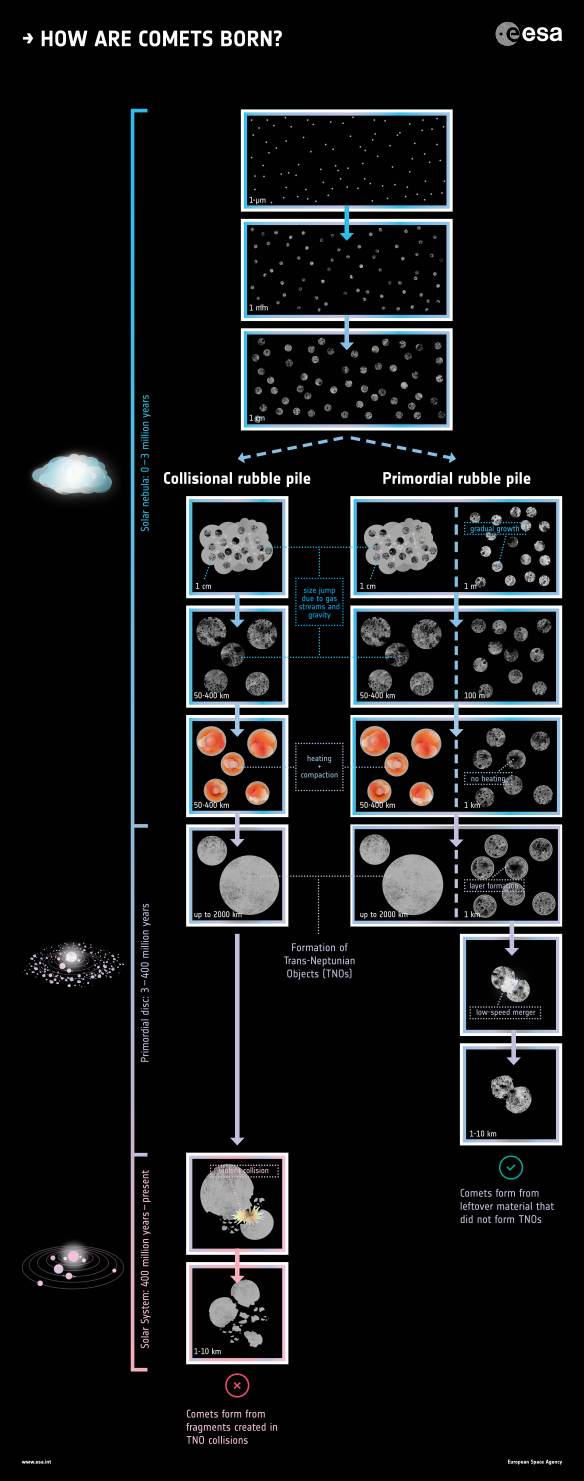
Figure 1: The left column of images shows how we often have imagined comet formation before Rosetta. Hierarchical agglomeration first builds pebbles with sizes around a centimeter. Streaming instabilities in the solar nebula then form gigantic swarms of pebbles that merge through gravity to large transneptunians with typical diameters in the range 100-400 kilometers. These then collide with each other – to begin with rather gently so that some of them merge to objects as large as Pluto (2300 km) or the Neptune satellite Triton (2700km) that was captured from the primordial disk. However, collision velocities increase over time and cease to be constructive (in which two smaller objects merge into a large one) and start to become destructive (two smaller objects pulverize each other). In some cases the collision fragments are joined into loosely bound lumps – many scientists see comets as such collision rubble piles. Our new scenario is seen to the right, with one column for large transneptunians and another for small comets. In our opinion the transneptunians form first through streaming instabilities. Remaining material then grows through hierarchical agglomeration to form comets. The growth rate of the comets is so slow that they have time to dissipate the heat generated internally by radioactive decay – therefore they remain very cold and porous. Due to their slow growth much of it takes place after the solar nebula gas has dissipated. In our opinion this gives comets some unique properties – their outer parts are dominated by concentric shells, and they often merge two by two. If comets form in this manner we demonstrate that they are so few in number that they do not collide violently with each other at later times. Comet nuclei are therefore surviving primordial rubble piles that are 4.6 billion years old.
Our new model of comet origins
In our scenario we assume that the primordial disk had a substantially lower mass than in the nominal version of the Nice model. We start off with the lowest mass – about 15 Earth masses – that still is consistent with the overall properties of the Nice model. Therefore, we do not reject the Nice model, but we feel forced to revise the assumption regarding the amount of mass. The reason for this is that we need to avoid an collisional cascade, since we think that the observations by Rosetta excludes that such a process took place. In our opinion 67P/Churyumov-Gerasimenko is a primordial rubble pile.
We demonstrate that the solar nebula initially had such properties that streaming instabilities should have been active. We therefore think that large transneptunians formed very early and we have reasons to claim that their diameters typically were in the range 50-400 kilometers. Since pebbles continuously are consumed in order to build large planetesimals they eventually become too few, compared to the amount of gas, for streaming instabilities to form new pebble swarms. We estimate that this happens when about 13 earth masses have been consumed.
At that point, about 2 earth masses remain in the form of centimeter-sized pebbles. The question is – what happens to those? We claim that this remaining material eventually form comet nuclei. We think that these pebbles start merging to increasingly large units, that is to say, a hierarchical agglomeration process takes place. As previously mentioned, this is a very slow form of growth. In our case it is even slower than in previous works since we start out with an unusually small amount of dust, furthermore, it is only a small fraction of this dust that grows through hierarchical agglomeration. The extremely slow growth is a problem if one want to form planets – but if one wants to form comets it is a necessity.
The thing is that the small pebbles contained a radioactive element called aluminum-26. When this radioactive substance decays heat is being generated. The large transneptunians will therefore experience strong heating and suffer structural, chemical, and mineralogical changes that we think can be seen among those bodies today. However, the comets must be kept extremely cold at all times since only extreme cold can explain why they still are so rich in very volatiles species, and how they managed to maintain an extremely high porosity.
It is much easier for small bodies to dissipate the heat produced (it escapes to space as infrared radiation), than for large bodies. It is therefore good that these cometesimals grew very slowly, since that gives them the chance to cool off.
We estimate that the cometesimals only had reached diameters between 100 meters and 1 kilometer when the solar system reached an age of 3 million years. A few bodies had grown as large as 5-6 kilometers. When the gas in the solar nebula started to dissipate, most comets had therefore not yet grown to their full final size.
The cometesimals that formed in this manner are extremely porous. They have systematically been built by the merger of smaller objects into bigger ones. Meetings between similarly-sized objects were very rare. Instead, meetings between a comparatively large body and a much smaller one have dominated. That affects the shape of the growing objects – they do not look like 67P/Churyumov-Gerasimenko at this stage, that consists of two large lumps (lobes) that attached to each other. These cometesimals are much more spherical, and look more like the individual lobes.
When the gas goes away the conditions for continued growth change completely. The presence of large transneptunians and the absence of drag forces gives rise to a phenomenon called ”viscous stirring”. The practical consequence is that cometesimals now collide with each other at ever increasing velocity (it increases from 0.1 meter per second to tens of meters per second). The rate of change is very slow, but it changes the appearance of the cometesimals.
The somewhat more violent collisions lead to the formation of a shell around the extremely porous cores, that are somewhat less porous. Layer upon layer of compressed material create a stratified outer shell on the cometesimals that resembles the layers in an onion. Another consequence of the viscous stirring is that cometesimals of similar size for the first time collide frequently in space. It is in these type of collisions that objects similar to 67P/Churyumov-Gerasimenko have formed. The collisions take place at sufficiently low velocity that the lobes do not destroy each other, they just gently attach.
We calculate in detail how the viscous stirring changes the collision velocities over time and estimate the number of large transneptunians and comets that collide within their groups and with each other at any given moment. Therefore, we can estimate how the number of objects and their sizes evolve over time. Previous work has shown that the primordial disk existed for about 400 million years. We show that about 350 transneptunians manage to grow to the size of Triton (2700 km) in this time. We also show that the growth phase of comets primarily is over once 20-25 million years have passed. The largest comet-sized objects have diameters of at least 50 kilometers, thus we claim that large comets like Hale-Bopp reached their full size when the solar system was about 25 million years old.
Due to low-velocity mergers and collisions with transneptunians that number of comet nuclei had been heavily reduced at this time. The fact is that they are so few that they do not manage to collide with each other when the viscous stirring has created such high relative velocities that collisions would have been destructive, if they occurred. This is good, because the primordial rubble piles therefore can survive throughout the solar system lifetime so that we can see them as comets.
When 400 million years have passed the giant planets will enter into the primordial disk and destroy it. We calculate in detail how many comets and large transneptunians that are places into the Edgeworth-Kuiper belt and into another population further from the sun called the scattered disk. The scattered disk is considered being the source region of the comets that currently manage to find their way into the inner solar system so that we can see them (67P/Churyumov-Gerasimenko is one of those).
There are several new things in our scenario. The primordial disk has an unusually small mass and is dynamically cold. We have completely separated the comets from the large transneptunians – the comets are not the precursors of transneptunians (as in classical hierarchical agglomeration) and the transneptunians are not the parents of comets (as in a collisional cascade). Instead we view the large transneptunians and the comets as two entirely different populations that formed out of the same building blocks (the centimeter-sized pebbles) but that evolve in different directions due to two completely different processes – in the case of transneptunians through streaming instabilities and in the case of comets through hierarchical agglomeration. It’s not a matter of ”either one or the other” – we believe in a hybrid where both mechanisms are active simultaneously.
Another novelty is that the number of comets may be much smaller than previously thought. Our model has about 100 times fewer comets in the primordial disk compared with previous estimates – we claim there were ”only” about three billion comets with diameters above 2 kilometers. The earlier estimates are based on the number of currently observed comets, combined with a large number of assumptions that lead backward from the inner solar system to the scattered disk, then backward to the days of the primordial disk. Although these estimates have been done ”by the book” we are not fully convinced of their correctness. If our estimate of a substantially lower number of comets is correct, it is easier to understand certain observational studies of the scattered disk, as well as the number of craters on the Moon.
If we are right it also means that rather few comets hit Earth in its childhood. They may have brought less water and organics to our planet than previously assumed. This does not necessarily mean that we need to exclude that comets played a part in the emergence of life on Earth – but we may have to think more in terms of quality rather than quantity.
More about that another time!
Literature
Davidsson, B. J. R., H. Sierks, C. Güttler, F. Marzari, M. Pajola, H. Rickman, M. F. A’Hearn, A.-T. Auger, M. R. El-Maarry, S. Fornasier, P. J. Gutiérrez, H. U. Keller, M. Massironi, C. Snodgrass, J.-B. Vincent, C. Barbieri, P. L. Lamy, R. Rodrigo, D. Koschny, M. A. Barucci, J.-L. Bertaux, I. Bertini, G. Cremonese, V. Da Deppo, S. Debei, M. De Cecco, C. Feller, M. Fulle, O. Groussin, S. F. Hviid, S. Höfner, W.-H. Ip, L. Jorda, J. Knollenberg, G. Kovacs, J.-R. Kramm, E. Kührt, M. Küppers, F. La Forgia, L. M. Lara, M. Lazzarin, J. J. Lopez Moreno, R. Moissl-Fraund, S. Mottola, G. Naletto, N. Oklay, N. Thomas, and C. Tubiana (2016). The primordial nucleus of comet 67P/Churyumov-Gerasimenko. Astronomy & Astrophysics, 592, A63.

